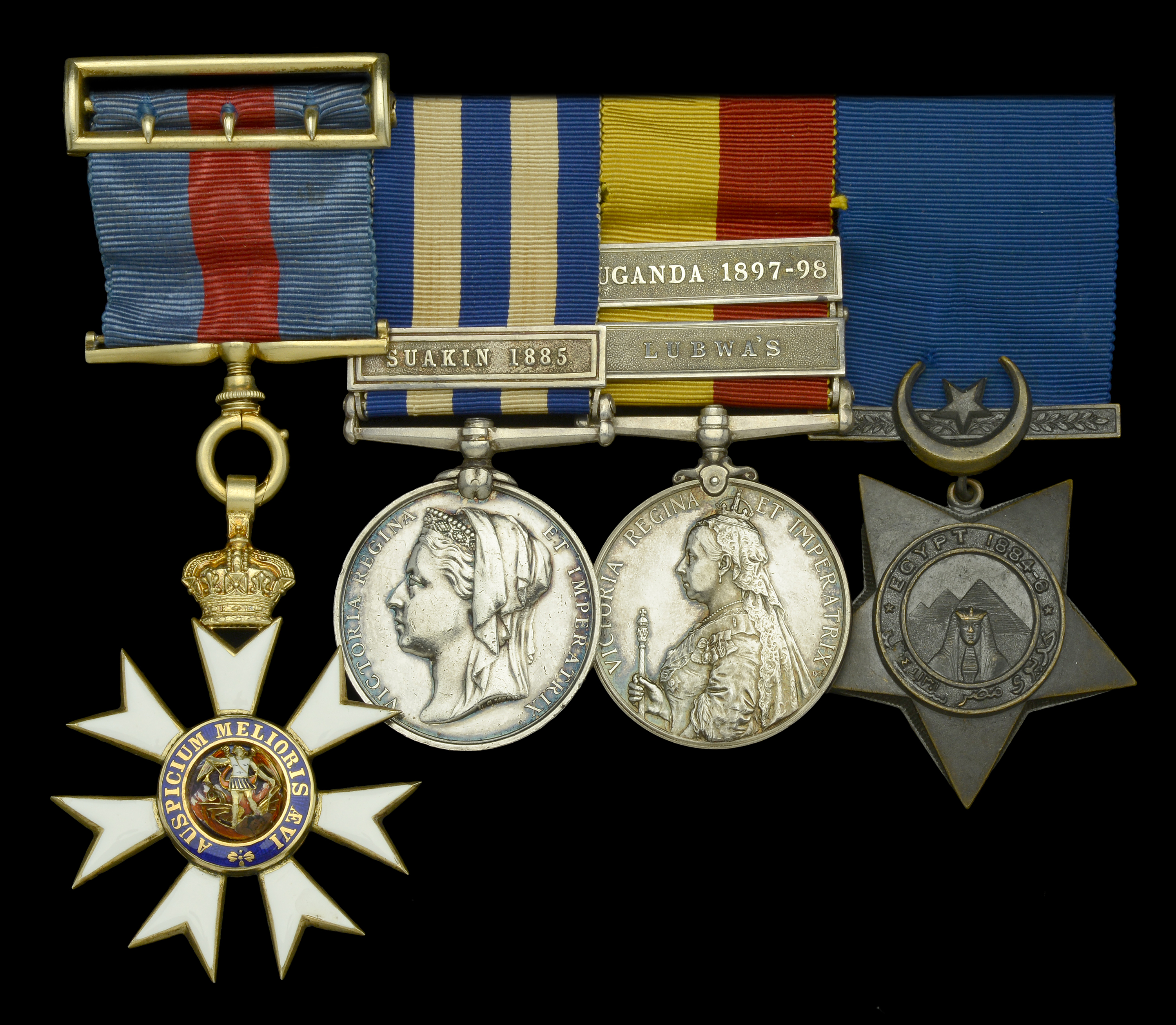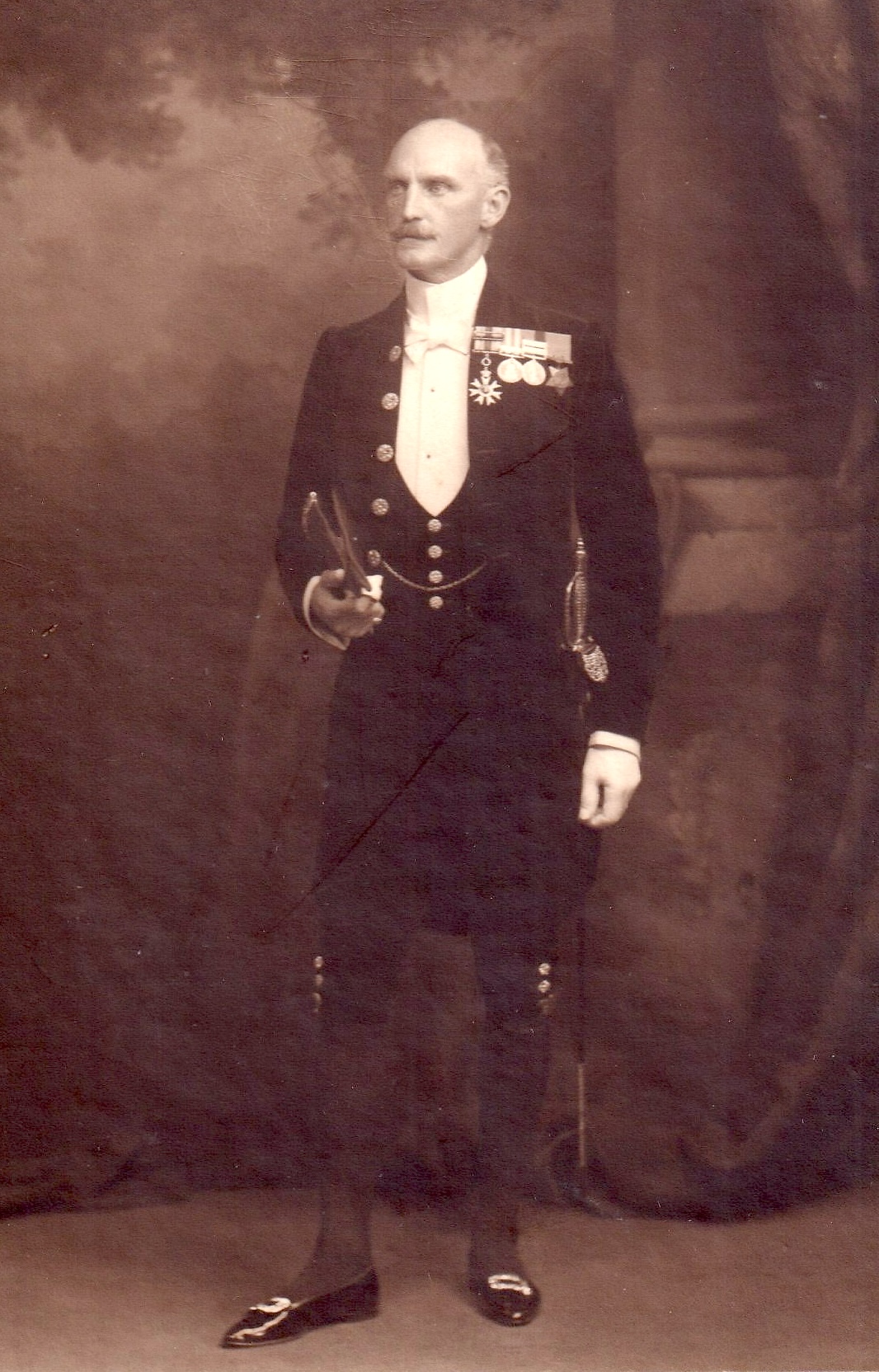The unique Uganda Mutiny C.M.G. group of four awarded to Lieutenant C. W. Fowler, Royal Navy The Most Distinguished Order of St. Michael and St. George, C.M.G., Companion’s, breast badge, silver-gilt and enamels, complete with ribbon buckle; Egypt and Sudan 1882-89, undated reverse, 1 clasp, Suakin 1885 (Lieut. C. W. Fowler, R.N. H.M.S. Carysfort) impressed naming; East and Central Africa 1897-99, 2 clasps, Lubwa’s, Uganda 1897-98 (Lt: C. W. Fowler, R.N.) mounted on original wearing bar together with related ribbon bar, nearly extremely fine (4) £8,000-£10,000 --- Importation Duty This lot is subject to importation duty of 5% on the hammer price unless exported outside the UK --- --- The clasp ‘Lubwa’s’ is unique to the Royal Navy. Charles Wilson Fowler was born in December 1859 in Cookham, Berkshire, the ninth of 13 children of Captain George Campbell Fowler, R.N. Like his father, he joined the Navy as a Cadet in January 1873, becoming Midshipman in June 1875, Sub-Lieutenant in April 1880, and Lieutenant in December 1883. He was Lieutenant of Carysfort during the naval and military operations near Suakin in 1884-85. Fowler was ‘allowed to resign from the navy to avoid court martial after sending a letter to his Captain accusing him without foundation of ‘scandalous conduct.’ He went to Uganda where he was appointed 3rd Class Assistant, Uganda Protectorate, in July 1896. He was Assistant Collector at Port Victoria, January to September 1897, and was at Lubwa’s during the Sudanese mutiny in November 1897. The mutineers were invested in Lubwa’s Fort by Captain E. M. Woodward, Leicester Regiment, with a very small force, and after several skirmishes they evacuated Lubwa’s and moved by launch and canoes up the Nile towards Mruli. Included in the medal rolls is Lieutenant Fowler, R.N., in command of 58 Swahilis. He was appointed 2nd Class Assistant and Superintendent of Marine in April 1898, and invested with the C.M.G. in January 1899 ‘for services rendered during the Uganda Mutiny’. The following extracts are taken from Major J. R. L. Macdonald’s official report and despatches: ‘Lieutenant C. W. Fowler, late R.N., was especially mentioned for his conduct in the engagement at Lubwa’s Hill, 19th October, 1897, again distinguished himself on the 24th November, though ill at the time. He was present at the fights of the 7th and 11th December, 1897, made a gallant effort to sink the enemy’s dhow on the 5th January, 1898, and subsequently served with the Unyoro column, and commanded in the minor engagement of the 10th April, 1898, when he inflicted a severe defeat on Mwanga’s Mahommedans.’ In more detail: Early October 1897: ‘Lieutenant Fowler, late R.N., at Port Victoria, also took steps to defend his fort, and to cut the bridges over the Sio River; but he was only able to partially carry out this step. On hearing that Lieutenant Fowler was in danger, Mr Jackson and I [Macdonald] advanced to his assistance with all the men we could raise.’ ‘On the 19th instant the mutineers, to the number of 300, assisted by some 150 Waganda Mahommedans, attacked our camp. The engagement commenced at 6 a.m. by a fierce attack on two sides of the camp, the mutineers coming on with the greatest determination. This attack was repulsed, but not until some had got within 50 yards of our line. The fight then continued until nearly 11 a.m., the mutineers bringing up supports, and making repeated attacks. About 11 a.m. when they appeared to have somewhat exhausted their attack, I made a counter-attack on the left with 100 Swahilis under Captain Kirkpatrick and Mr Mayes, on the right a few Swahilis under Lieutenant Fowler, assisted by some fifty Wasoga under a sub-Chief called Kyrania. This counter-attack was completely successful, and the enemy were driven down the hill, and retired to the fort, where they have since remained. Our total loss amounted to 16 killed, 18 severely wounded, and 12 slightly wounded. I cannot speak too highly of the gallantry of the Europeans and Indians. The Wasoga, as a result of our victory, came forward in large numbers, and on the 20th we were joined by an army of Waganda under the Sekebobo. The enemy are now invested in the fort.’ ‘Lieutenant Fowler kept his men incessantly at hand, assisted in repulsing the first attack on our right, and took part in the final counter-attack, when his courage and judgement were productive of the best results.’ ‘On the 14th January [1898] Lieutenant Fowler took the steam-launch and a sailing boat which had meanwhile arrived close to the enemy’s new fort under a heavy fire, and shelled their dhow, with a view to rendering it useless.’ ‘On the night between the 4th and 5th January the mutineers began effecting their escape from the fort by means of this vessel. A party of some sixty embarked and crossed to a small promontory lying north of the station... and proceeded to intrench themselves. On the second night Lieutenant Fowler, late R.N., made efforts with canoes and a Maxim to sink the dhow but without success, as the gun jammed, with a broken mainspring, and from that moment his canoemen absolutely refused to go anywhere near the dhow.’ ‘On the 14th January Lieutenant Fowler succeeded in getting near enough to the dhow to severely damage it with Hotchkiss fire, and on the following day the mutineers themselves destroyed it.’ ‘On the 10th April, 1898, Lieutenant Fowler and Corporal Brodie, acting under the orders of Captain Harrison, with a column of under 100 men, surprised the Mahommedan camp in Bugoma, and, after a brisk fight, in which he lost eleven killed and wounded, completely defeated the enemy and vigourously pursued them. The enemy lost fifty-five killed and twenty prisoners, and their camp and baggage.’ His last appointment appears to have been as Sub-Commissioner of the Nile Province. He died on 19 March 1907. The group is accompanied by two fine portrait photographs of Fowler wearing these medals; original letter notifying him of his appointment to be Commander of St Michael and St George ‘for services rendered during the Uganda Mutiny’; and original warrant for C.M.G. and accompanying transmission document, 23 January 1899.









